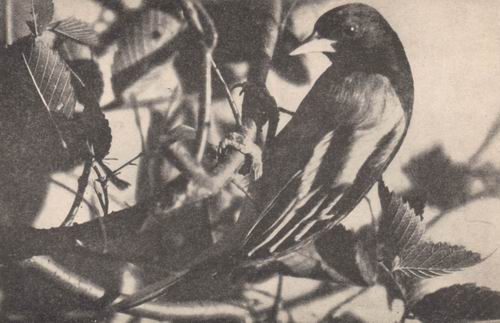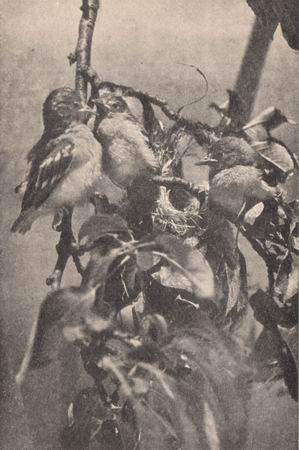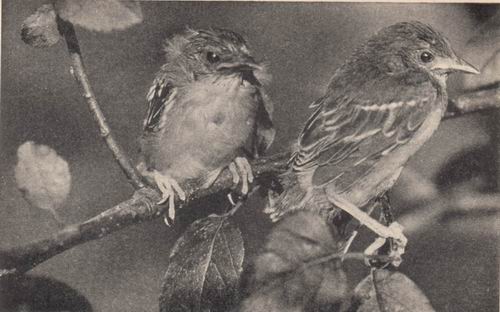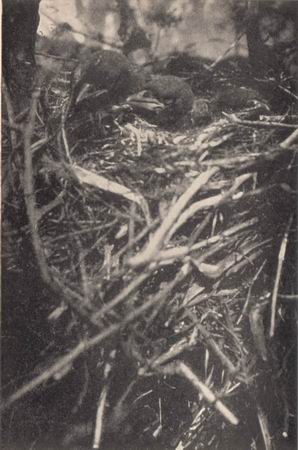|
1999-2004 (Return to Web Text-ures) |
Click Here to return to Birds Every Child Should Know Content Page Click Here to return to last Chapter |
 (HOME) |
|
1999-2004 (Return to Web Text-ures) |
Click Here to return to Birds Every Child Should Know Content Page Click Here to return to last Chapter |
 (HOME) |
|
CHAPTER IX
THE ILL-ASSORTED BLACKBIRD FAMILY BOBOLINK COWBIRD RED-WINGED BLACKBIRD RUSTY BLACKBIRD MEADOWLARK ORCHARD ORIOLE BALTIMORE ORIOLE PURPLE AND BRONZED GRACKLES BOBOLINK Called also: Reedbird; Ricebird; Ortolan; Maybird Such a rollicking, jolly singer is the bobolink! On a May morning, when buttercups spangle the fresh grasses in the meadows, he rises from their midst into the air with the merriest frolic of a song you ever heard. Loud, clear, strong, full of queer kinks and twists that could not possibly be written down in our musical scale, the rippling, reckless music seems to keep his wings in motion as well as his throat; for when it suddenly bursts forth, up he shoots into the air like a skylark, and paddles himself along with just the tips of his wings while it is the "mad music" that seemingly propels him: -- then he drops with his song into the grass again. Frequently he pours out his hilarious melody while swaying on the slender stems of the grasses, propped by the stiff, pointed feathers of his tail. A score or more of bobolinks rising in some open meadow all day long, are worth travelling miles to hear. If you were to see the mate of one of these merry minstrels apart from him, you might easily mistake her for another of those tiresome sparrows. A brown, streaked bird, with some buff and a few white feathers, she shades into the colours of the ground as well as they and covers her loose heap of twigs, leaves and grasses in the hay field so harmoniously that few people ever find it or the clever sitter. As early as the Fourth of July, bobolinks begin to desert the choir, being the first birds to leave us. Travelling southward by easy stages, they feed on the wild rice in the marshes until, late in August, enormous flocks reach the cultivated rice fields of South Carolina and Georgia. On the way, a great transformation has gradually taken place in the male bobolink's dress. At the North he wore a black, buff and white wedding garment, with the unique distinction of being lighter above than below; but this he has exchanged, feather by feather, for a striped, brown, sparrowy winter suit like his mate's and children's, only with a little more buff about it. In this inconspicuous dress the reedbirds, or ricebirds, as bobolinks are usually called south of Mason and Dixon's line, descend in hordes upon the, rice plantations when the grain is in the milk, and do several millions of dollars' worth of damage to the crop every year, sad, sad to tell. Of course, the birds are snared, shot, poisoned. In southern markets half a dozen of them on a skewer may be bought, plucked and ready for the oven, for fifty cents or less. Isn't this a tragic fate to overtake our joyous songsters? Birds that have the misfortune to like anything planted by man, pay a terribly heavy penalty. Such bobolinks as escape death, leave this country by way of Florida and continue their four thousand mile journey to southern Brazil, where they spend the winter; yet, nothing daunted by the tragedies in the rice fields, they dare return to us by the same route in May. By this time the males have made another complete change of feather to go a-courting. Most birds are content to moult once a year, just after nursery duties have ended; some, it is true, put on a partially new suit in the following spring, retaining only their old wing and tail feathers; but a very few, the bobolink, goldfinch, and scarlet tanager among them, undergo as complete a change as Harlequin.
COWBIRD
This contemptible bird every child should know if for no better reason than to despise it. You will see it alone or in small flocks walking about the pastures after the cattle; or, in the West, boldly perching upon their backs to feed upon the insect parasites -- a pleasant visitor for the cows. So far, so good. The male is a shining, greenish-black bird, smaller than a robin, with a coffee-brown head and neck. His morals are awful, for he makes violent love to any brownish-gray cowbird he fancies but mates with none. What should be his song is a squeaking kluck tse-e-e, squeezed out with difficulty, or a gurgle, like water being poured from a bottle. When he goes a-wooing, he behaves ridiculously, parading with spread wings and tail and acting as if he were violently nauseated in the presence of the lady. Fancy a cousin of the musical bobolink behaving so! And nothing good can be said for the female cowbird. Shirking as she does every motherly duty, she sneaks about the woods and thickets, slyly watching her chance to lay an egg in the cradle of some other bird, since she never makes a nest of her own. Thus she scatters her prospective family throughout the neighbourhood. The yellow warbler, who is a famous sufferer from her visits, sometimes outwits her, as we have seen; but other warblers, less clever, the vireos, some sparrows, and, more rarely, woodpeckers, flycatchers, orioles, thrushes and wrens, seem to accept the unwelcome gift without a protest. If you were a bird so imposed upon, wouldn't you peck holes in that egg, or roll it out of your nest, or build another cradle rather than hatch a big, greedy interloper that would smother and starve your own babies? Probably every cowbird you see has sacrificed the lives of at least part of a brood of valuable, insectivorous songsters. Without the least spark of gratitude in its cold heart, a young cowbird grafter forsakes its over-kind foster parents as soon as it can pick up its living and remains henceforth among its own kin of whom only cows could think well.
RED-WINGED BLACKBIRD Called also: Swamp Blackbird When you are looking for the first pussy willows in the frozen marshes, or listening to the peeping of young frogs some day in early spring, you will, no doubt, become acquainted with this handsome blackbird, with red and orange epaulettes on his shoulders, who has just returned from the South. "Ke, kong ker-ee," he flutes from the willows and alders about the reedy meadows where he and his bachelor friends flock together and make them ring "with social cheer and jubilee." A little later, flocks of dingy, brown, streaked birds, travelling northward, pause to rest in the marshes. Wholesale courting takes place shortly after and every red-wing in a black uniform chooses one of the plain, streaked, matter-of-fact birds for his mate. The remainder continue their unmaidenly journey in search of husbands, whom they find waiting in cheerful readiness in almost any marsh. By the first of May all have settled down to home life: Then how constant are the rich, liquid, sweet o-ka-lee notes of the red-wing! Ever in foolish fear for the safety of his nest, he advertises its whereabouts in musical headlines from the top of the nearest tree, or circles around it on fluttering wings above the sedges, or chucks at any trespasser near it until one might easily torture him by going straight to its site. But how short-lived is this excessive devotion to his family! In July, the restless young birds flock with the mothers, but the now indifferent fathers keep apart by themselves. Strange conduct for such fussy, solicitous birds! They congregate in large numbers where the wild rice is ripening and make short excursions to the farmers' fields, where they destroy some grain, it is true, but so little as compared with the quantity of injurious insects and weed seed, that the debt is largely in the red-wings' favour.
RUSTY BLACKBIRD Called also: Thrush Blackbird This cousin of the red-wing, whom it resembles in size, flight and notes, is a common migrant in the United States. Nesting is done farther north. In spring, the rusty blackbirds come from the South in pairs, already mated, whereas the red-wings and grackles travel then in flocks. At that time the males are a uniform glossy, bluish-black, and their mates a slate gray, darker above than below; but after the summer moult, when they gather in small companies, both are decidedly rusty. You might mistake them for grackles in the spring, but never for male red-wings then with their bright epaulettes. Notice the rusty blackbird's pale yellow eye.
MEADOWLARK Called also: Old-field Lark; Meadow Starling Every farmer's boy knows his father's friend, the meadowlark, the brownish, mottled bird, larger than a robin, with a lovely yellow breast and black crescent on it, that keeps well hidden in the grass of the meadows or grain fields. Of course he knows, too, that it is not really a lark, but a starling. When the shy bird takes wing, note the white feathers on the sides of its tail to be sure it is not the big, brownish flicker, who wears a patch of white feathers on its lower back, conspicuous as it flies. The meadowlark has the impolite habit of turning its back upon one as if it thought its yellow breast too beautiful for human eyes to gaze at. It flaps and sails through the air much like bob-white. But flying is not its specialty. It is, however, a strong-legged, active walker, and rarely rises from the ground unless an intruder gets very near, when away it flies, with a nasal, sputtered alarm note, to alight upon a fence rail or other low perch. The tender, sweet, plaintive, flute-like whistle, Spring-o'-the-year, is a deliberate song usually given from some favourite platform-a stump, a rock, a fence or a mound, to which the bird goes for his musical performance only. He sings on and on delightfully, not always the same song, for he has several in his repertoire, and charms all listeners, although he cares to please none but his mate, that looks just like him. She keeps well concealed among the grasses where her grassy nest is almost impossible to find, especially if it be partly arched over at the top. No farmer who realises what an enormous number of grasshoppers, not to mention other destructive insects, meadowlarks destroy, is foolish enough to let his mowing-machine pass over their nests if he can but locate them. By the time the hay is ready for cutting in June, the active meadowlark babies are usually running about through grassy run-ways, but eggs of the second brood too frequently, alas! meet a tragic end.
ORCHARD ORIOLE Fortunately many other birds besides this oriole prefer to live in orchards; otherwise think how many worm-eaten apples there would be! He usually has the kingbird for company, and, strange to say, keeps on friendly terms with that rather exclusive fellow; also the robin, the bluebird, the cedar waxwing and several other feathered neighbours who show a preference for fruit trees when it is time to nest. You may know the orchard oriole's cradle by its excellent weaving. It is not a deep, swinging pouch, like the Baltimore oriole's, but a well-rounded cup, more like a vireo's, formed of grasses of nearly even length and width, cut green and woven with far more skill and precision than a basket made by a boy or a girl is apt to be. Look for it near the end of a limb, ten to twenty feet up. It is by no means easily seen when the green, grassy cup matches the colour of the leaves. The mother oriole is so harmoniously dressed in grayish olive green, more yellowish underneath, that you may scarcely notice her as she glides among the trees; but her mate is more conspicuous, however quietly dressed in black and reddish chestnut -- even sombrely dressed as compared with his flashy orange and black cousin, the Baltimore oriole. Nevertheless, it takes him two, or possibly three years to attain his fine clothes. By that time his song is rich, sweet and strong. Do orioles generally take special delight in the music of a piano? An orchard oriole who used to come close to our house to feed on the basket worms dangling from a tamarix bush, returned long after the last worm had been eaten whenever someone touched the keys. And I have known more than one Baltimore oriole to fly about the house, joyously singing, as if attracted and excited by the music in-doors.  The gorgeous Baltimore oriole  How do you suppose these young Baltimore orioles ever packed themselves into so small a nest?
BALTIMORE ORIOLE
Called also: Firebird; Golden Robin; Hang-nest; Golden Oriole A flash of flame among the tender young spring foliage; a rich, high, whistled song from the blossoming cherry trees, and every child knows that the sociable Baltimore oriole has just returned from Central America. Brilliant orange and black feathers like his could no more be concealed than the fiery little redstart's; and as if they alone were not enough to advertise his welcome presence in the neighbourhood, he keeps up a rich, ringing, insistent whistle that you can quickly learn to imitate. You have often started all the roosters in your neighbourhood to crowing, no doubt; even so you can "whistle up" the mystified orioles, who are always disposed to live near our homes. Although the Baltimore oriole has a Southern name, he is really more common at the North, whereas the orchard oriole is more at home south of New England. Lady Baltimore, who wears a yellowish-olive dress with dusky wings and tail, has the reputation of being one of the finest nest builders in the world. To the end of a branch of some tall shade tree, preferably an elm or willow, although almost any large tree on a lawn or roadside may suit her, she carries grasses, plant fibre, string, or bits of cloth. These she weaves and felts into a perfect bag six or seven inches deep and lines it with finer grasses, hair and wool -- a safe, cozy, swinging cradle for her babies. But, as you may imagine, those babies have a rather hard time when they try to climb out of it into the world. Many a one tumbles to the ground, unable to hold on to the tip of a swaying twig, and not being strong enough to fly. Then what a tremendous fuss the parents make! They cannot carry the youngster up into the tree; they are in deadly fear of cats; they are too worried and excited to leave him alone; but the plucky little fellow usually hops toward the tree and with the help of his sharp claws on the rough bark, flutters his way up to the first limb. People who have brought up broods of orphan orioles say that they are unusually lively, interesting pets. The little girl orioles will attempt, instinctively, to weave worsted, string, grass, or whatever is given them to play with, for of course they never took a lesson in weaving from their expert mother.
THE PURPLE AND THE BRONZED GRACKLES Called also: Crow Blackbirds You probably know either one of our two crow blackbirds, similar in size and habits, one with purplish, iridescent plumage, the commonest grackle east of the Alleghanies and south of Massachusetts, and the bronzed grackle, with brassy tints in his black plumage, who overruns the Western country and from Massachusetts northward. Both have uncanny, yellow eyes that make you suspect they may be witches in disguise. Their mates are a trifle smaller and duller. When the trees are still leafless in earliest spring and the ground is brown and cold, flocks of blackbirds dot the bare trees or take shelter from March winds among their favourite evergreens, or walk solemnly about on the earth like small crows, feeding on fat white grubs and beetles in a business-like way. They are singularly joyless birds. A croaking, wheezy whistle, like the sound of a cart wheel that needs axle-grease, expresses whatever pleasure they may have in life. Always sociable, living in flocks the entire year through, it is in autumn only that they band together in enormous numbers, and in the West especially, do serious havoc in the cornfields. However, they do incalculable good as insect destroyers, so the farmers must for give the "maize thieves."
*
*
*
*
*
*
*
Was ever a family so ill-assorted as the blackbird and oriole clan? What traits are common to every member of it? Not one, that I know. Some of the family, as you have seen, are gorgeously clad, like the Baltimore oriole; some quite plainly, like the cowbird; and although black seems to be a prevalent colour in the plumage, the meadowlark, for example, is a brown bird with only a black crescent on its breast. Most of the males are dressed quite differently from their mates, although the female grackles are merely duller. Some of these birds sing exquisitely; others wheeze or croak a few unmusical notes. Some live in huge flocks; some live in couples. Some, like the bobolinks, travel to the tropics and beyond every winter; others, like the meadowlark, can endure the intense cold of the North. Part of the family feed upon the ground, but the oriole branch live in the trees. Devotion to mates and children characterise most of the family, but we cannot overlook the cowbird that neither mates nor takes the slightest care of its offspring. The cowbird builds no nest, while its cousin, the Baltimore oriole, is a famous weaver. The bobolink is a rollicking, jolly fellow; the grackle as solemn, even morose. What a queer family!  Young orchard orioles  “There were three crows sat on a tree” |